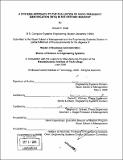A systems approach to the evaluation of Radio Frequency Identification (RFID) in the defense industry
Author(s)
Shah, Ronak R
DownloadFull printable version (5.561Mb)
Other Contributors
Leaders for Manufacturing Program.
Advisor
Daniel E. Whitney and Stephen C. Graves.
Terms of use
Metadata
Show full item recordAbstract
Radio Frequency Identification (RFID) is a wireless technology with possible applications in the supply chain. RFID tags' fast read rates, non-line-of-sight identification and large storage capacity may revolutionize supply chains in the defense industry and commercial world. Widespread adoption of RFID will require that companies achieve a return on their investment. System interactions between the implementation decisions, costs, benefits and performance of an RFID installation makes determining the optimal RFID system difficult. This thesis enumerates the various choices which affect the return on investment and describes how each is dependent upon the others. Formulating the problem as a optimization program allows one to maximize the return on investment. A three-stage process is proposed for evaluating RFID opportunities in any complex enterprise. RFID swim lanes, a new process mapping tool, is used in order to understand the complexities of material flow through facilities. A Microsoft Excel TM tool is used to formulate the optimization for the specific facility or enterprise contemplating RFID. (cont.) Finally, financial modeling is used in conjunction with optimization algorithms in order to determine the best course of action. In order to validate this approach, the process was followed to evaluate inbound materials opportunities at Raytheon's Integrated Air Defense Center. For this facility and others, there may be tremendous difficulty in achieving a return on investment at this time. However, the process ensures that the evaluation of RFID is performed thoroughly.
Description
Thesis (M.B.A.)--Massachusetts Institute of Technology, Sloan School of Management; and, (S.M.)--Massachusetts Institute of Technology, Engineering Systems Division; in conjunction with the Leaders for Manufacturing Program at MIT, 2005. Includes bibliographical references (p. 75-77).
Date issued
2005Department
Leaders for Manufacturing Program at MIT; Massachusetts Institute of Technology. Engineering Systems Division; Sloan School of ManagementPublisher
Massachusetts Institute of Technology
Keywords
Sloan School of Management., Engineering Systems Division., Leaders for Manufacturing Program.